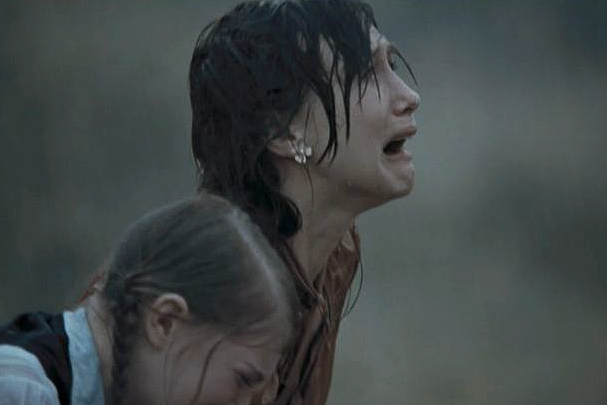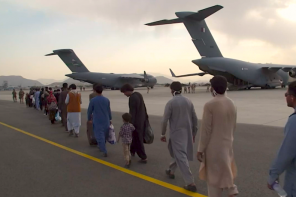If Hollywood is any indicator, one of the nation’s great romantic fantasies is to fall in love in the presence of death, a desire that animates two high-grossing genres. Let’s call the first kill-and-banter flicks. Specimens include the latest Avengers movie, and anything from the Bond franchise. In kill-and-banter films, the main characters team up to take out some bad guys. While killing, they flirt. Sometimes, when the combat quiets down, things will get hot and heavy, but often it’s just a lot of talk—Scarlett Johansson shooting an intergalactic invader while she chats about weekend plans with Chris Evans’ Captain America.
In cadaver-and-crush films, the protagonists are detectives whose hunt for a killer becomes entangled with their quest for love. “Bones,” the long-running Fox hit, is a textbook case. “Traces of her blood will still be in that cement,” says Dr. Temperance Brennan in the pilot, her face inches from that of Seeley Booth, her crime-fighting partner. Forensics as foreplay. Here, the banter takes place in coroners’ offices and stakeouts, with that same enticing juxtaposition of seriousness and seduction.
Perhaps media consumers have a heap of repressed necrophilia, but I think there’s something more mundane about the axis binding sex and death. To have sex appeal is to wield a particular kind of power; to be sexy is something more—to be powerful and at ease about that power at the same time. What could be sexier than nonchalance in the face of killing?
On-screen fictions are fantasies, and there is something fraught about moralizing your way through the collective dreamspace. So, withholding judgment, let’s just highlight the obvious disjuncts: we are a country at war, that prides itself on valuing individual lives. Meanwhile, our blockbuster fictions depict violence in a kind of alterverse, where killing is consequence-less, sexy, and fun.
Sometimes it takes a genre-bender to excavate these contradictions. In this sense, Suzanne Collins’ Hunger Games series is revolutionary. Yes, fine, let’s get the disclaimers out of the way: it’s decadent mass culture, the writing’s not great, Hollywood is a capitalist cesspool, I’m an adult writing about kid-lit, and—are we done yet? Despite all of this, Collins has subverted the kill-and-banter of the action genre. She has transcended the consequence-free violence that animates children’s literature, too. The final Hunger Games movie, out this week, is the conclusion of one of the grittiest, darkest multimedia-blockbusters of the past 20 years—a hit finely keyed to the zeitgeist.
I’m talking about PTSD. Don’t take my word for it. Ask some psychiatrists: Katniss Everdeen, the protagonist of Collins’ series, is haunted. And not in a romantic, mysterious-in-her-misery kind or way—I mean crushingly, lastingly, there-is-no-happy-ending-to-this-story haunted by the violence she has inflicted, and been subject to. Collins packages Katniss’s disturbance in the hallmark symptoms of posttraumatic stress disorder, including flashbacks, nightmares, avoidance of triggers, guilt, and sudden reactivity.
Once you see this, other young adult fiction seems oddly heartless. How do the kids in Narnia stay so cheery, after watching battles and bloodshed? How does Harry Potter stay mellow amidst the carnage?
Will the movie’s director gloss over the consequences of the violence, and gravitate back to the standards of the action-adventure genre? Or will the last movie stay true to the books, and find a way to depict violence and its consequences? Those questions strike at the odd ways that we divvy up violence in our fictions—and the question of how far that divvying should go, here in the era of PTSD.
Not Adolescence, But War
Suzanne Collins grew up in a military family. Her father served in Vietnam when she was a small child. He dreamed of the war for the rest of his life. As a child, Collins would be awakened by his cries.
Some critics read the Hunger Games trilogy as a parable of adolescence and its struggles. But, Collins told the New York Times Magazine in a rare interview, “I don’t write about adolescence. I write about war. For adolescents.” The idea for the series came to Collins while she was watching TV. On one channel, there was a reality TV show. On the other, there was footage from the Iraq War. Ergo, the basic premise, which is a kind of Theseus-and-the-Minotaur/“Survivor”/Gladiator mashup: a reality TV show, in a dystopian future, where children kill each other in an arena, all for the entertainment of elites.
Collins wrote the Hunger Games in the first person, from the perspective of Katniss. Violence drives the plot, but always through the fractured prism of a teenager’s experience. In the movies, though, we switch back to the third person angle. The tension becomes less personal and more sensational. Onscreen, then, the plot yields to a strange paradox: the movies offer a dystopian critique of a culture that treats violence as entertainment. In order to make the social commentary enticing, the series entertains moviegoers with…violence.
Is this a sly meta-critique? Maybe. Either way, it’s a rare blend: an action-adventure film that suddenly pivots to deal with the consequences of its carnage. “The conjunction that you describe is pretty unusual in adventure films,” said Stephen Prince, a film studies scholar at Virginia Tech who has written extensively about cinematic violence. “In order not to upset audiences too much, [action-adventure filmmakers] tend to remove the pain and suffering from violence.”
Hollywood has a long history of sanitizing violence onscreen. In 1930, the Association of Motion Picture Producers approved a new production code that would support “the maintenance of social and community values in pictures.” For the next 38 years, that code shaped Hollywood’s output. The Production Code insisted that movies were primarily “to be regarded as entertainment” that would “improve the race.” As such, movies should avoid explicit images that would be upsetting or play to “the lower and base element.” Those images included graphic violence, “excessive passion,” “white-slavery,” “scenes of actual child birth,” and illegal drinking.
Directors still made films about war, of course, and violent genres like the Western flourished. Under the Production Code, though, that violence had to be stylized. The Code had a broader effect of pushing filmmakers “to avoid any overt signs of pain or suffering,” explained Prince. That would have included psychological reactions to violence, as well as more explicit depictions of physical harm.
As the influence of the Code waned, and finally collapsed, in the 1960s, violence became more explicit. So did depictions of the emotional and psychological turmoil that can accompany killing. Still, the more psychologically-charged territory of dramas often exists in a genre apart from the casual violence of action-driven feature films. Sometimes, films obscure both the physical and psychological effects of violence. Other times (think of Quentin Tarantino movies), the physical violence is explicit. But these films are sanitized too, only more subtly: the suffering is still kept distinct from any kind of personal or social repercussion. The losers’ bodies break; the victors’ minds stay placid.
It is as if we have two modes with which to approach death: one of intense and personal engagement (the mode of tragedy), and another of disassociation. That’s not to say that the kill-and-banter and cadaver-and-crush genres are morally bankrupt. They offer fantasies of invulnerability. They are superhero movies—and, as Prince put it, “superheroes by definition don’t ever get hurt.”
I’m hesitant to moralize about fantasy. But fantasies aren’t always morally neutral. Sometimes, these films openly tackle political issues: movies like Batman and Avenger flicks express ambivalence about the surveillance state, government power, corporate influence, and other charged topics. Other times, narratives onscreen seem to mingle with political narratives offscreen, making war into an unambiguous battle between good and evil. And, more generally, these movies can feel out of place in a society where war seems less and less about bodies, and more and more about minds.
Trauma Town
In the past decade, it has become more difficult to ignore the psychological toll of violence. Effective activism, shifts in media coverage, and changing public perceptions of mental health have probably all played a role in this shift. But the conflicts in Afghanistan and Iraq have also been the first major American wars during which the country had an established, stable psychological diagnosis for combat stress. For the first time, there’s a highly-visible, medically-legible pool of veterans whose experiences of war diverge radically from anything resembling a kill-and-banter escapade.
The effects of traumatic stress have been recognized for a long time–perhaps millennia–and, in the modern world, they have gone by a range of names—shell shock, combat fatigue, traumatic war neurosis. (For these and other details, I’m indebted to neuroscientist Nancy Andreasen’s work). In 1952, the first-ever edition of the Diagnostic and Statistical Manual of Mental Disorders included an entry for gross stress reaction. In the DSM-II, the entry was removed. “The most plausible explanation for the omission is that the concept was closely linked to warfare and combat, and DSM-II was written in a peaceful era,” writes Andreasen.
The timing could not have been much worse. America’s involvement in the Vietnam War was just beginning to escalate; the DSM-II was published the same year as the Tet Offensive. Thousands of veterans came home with severe combat stress. But “between 1968 and 1980 no official diagnosis for stress disorders was available,” Andreasen writes. PTSD entered the lexicon with the 1980 publication of DSM-III.
If we imagine the range of human experiences as a landscape, then the creation of a diagnosis is bit like a incorporating a city. It does not create the houses or the people who live there, but it gives them boundaries with which to define themselves. It allows them to be recognized by the state at large, and to advocate for services. Some people will be left out of those incorporated boundaries. There will always be conflict. But it’s a powerful tool. Since the wars in Afghanistan and Iraq, a lot of people have moved into PTSD town, and a lot more people know someone who lives there.
A diagnosis makes a psychological condition more legible to the state, but also to the culture at large. Katniss’s PTSD isn’t an accident of perceptive fiction. It’s an authorial diagnosis. “She’s got a lot of classic post-traumatic stress disorder symptoms,” Collins told TIME’s Lev Grossman in a 2013 interview. “She has nightmares. She has flashbacks. And in the beginning you can see she’s practicing avoidance.”
That depiction serves a larger end. “I think that it’s very uncomfortable for people to talk to children about war,” Collins told Grossman. “But then you have young people at 18 who are enlisting in the army and they really don’t have the slightest idea what they’re getting into. I think we put our children at an enormous disadvantage by not educating them in war, by not letting them understand about it from a very early age.”
How accurate is this education? I called up Rodney Deaton to ask about the movie’s depiction of violence and trauma. A clinical psychiatrist in Nashville, Deaton works almost exclusively with combat veterans, both in government and private practices, and he has written extensively about the Hunger Games on his blog. Deaton describes talking with a combat veteran whose son was reading the books:
“So when my son tries to understand all that I go through,” he asked, ” all that’s happened to me and all that keeps happening to me, could I say to him, ‘Remember the kids in those books, what they went through, how they felt?’”
The answer to those questions is, in my opinion, a most definite yes.
Over the phone, Deaton explained that Collins captures the helplessness of its hero–and, through that sense of helplessness, the dynamics of trauma. “Trauma really is about the moment of freezing,” said Deaton. “What is traumatic is when there’s nothing that can be done.” Collins, he said, sustains a kind of trapped tension throughout the books—that feeling that you’re “never really in a safe place.”
After speaking with Deaton, I found myself thinking more about that concept of safety. In contemporary warfare, the battlefield lacks a clearly defined frontline. The danger is everywhere, such that you cannot control your removal from the field of action. With the Paris attacks over the weekend, that diffusion of danger seems only magnified. Killers come from among your fellow citizens. Wars in Syria spill over into Paris, and then echo back to the Middle East. Fear itself becomes the weapon; there’s a reason we call it terrorism.
When war becomes uncoupled from specific places, the timbre of trauma changes. Drone operators now suffer from PTSD, stemming from the strikes that they performed and witnessed through cameras, at a distance of hundreds or thousands of miles. Veteran suicides come to outnumber battlefield deaths. Violence shifts even deeper into the realm of psychology: there’s the pervasive fear of a possible strike, existing alongside the lasting legacy of combat.
The final chapters of the Hunger Games series concern themselves with trauma and its aftermath, in unusually naked terms (“I still remain struck with the last two chapters. It just was so completely accurate that I don’t know what to make of it,” said Deaton). This weekend, moviegoers will see how this depiction adapts itself to the screen. The question of the Hunger Games is whether there’s a way to have it all: the aesthetic thrill of violence, and recognition of the ambiguity of that violence–and the ambiguity of the thrill.
Here are the old hallmarks of action-adventure culture, attuned to the new landscape of wounds. All that’s left is to see whether the story will continue to sate moviegoers’ hunger.
____________
Note: Right before beginning this piece, I drove by Ryan Weldon on a highway outside of Bangs, Tex.. Weldon had an enormous American flag strapped to his back, and he was wearing a sign that said he was walking 5,000 miles in order to raise awareness about PTSD. I stopped and walked for a mile with him. A Marine Corps veteran, Weldon had a vivid dream on the night before Christmas, and woke up resolved to walk across the country, raising awareness about PTSD and veteran suicide. –MS
You can follow his journey on Facebook or check out his profile on GoFundMe.





